
AMD Athlon XP 2600+: The Resistance Strikes Back
By Van Smith
Date: August 21, 2002
Advanced Micro Devices launched the world's best performing desktop microprocessor today. According to our exhaustive tests, the AMD Athlon XP 2600+ clearly provides more processing punch than its fastest Intel Pentium 4 rival.
We have discussed in previous articles the dramatically different approach taken by AMD and Intel in their flagship desktop processors. While Intel is able to push their 0.13-micron Northwood core to somewhat higher clockspeeds, the Athlon XP is consistently much more efficient at any given frequency. As a consequence, the Athlon XP can often outpace a Pentium 4 running at much higher clock speeds.
This is the case with the Athlon XP 2600+ and the fastest Intel Pentium 4. Operating at only 2.133 GHz, the Athlon XP 2600+ is consistently quicker than the 2.53MHz Pentium 4. In fact, the lead is so great on some applications that even Intel's upcoming 2.8GHz Pentium 4 will not be enough to catch up.
===================================
New Products
In addition to the Athlon XP 2600+, AMD also introduced the Athlon XP 2400+. The 2600+ operates at 2.133 GHz while the 2400+ runs at 2 GHz, up 200 MHz from the Athlon XP 2200+ bringing more “bang for the buck” to these new offerings.
The Athlon XP 2600+ sells for $297 while the 2400+ goes for a much cheaper $193. Given its 200MHz extra "omph," the 2400+ is probably AMD's best bargain. Here is the chipmaker’s latest pricing guide:
|
model 2600+ |
$297 |
|
model 2400+ |
$193 |
|
model 2200+ |
$183 |
|
model 2100+ |
$174 |
|
model 2000+ |
$155 |
|
model 1900+ |
$139 |
|
model 1800+ |
$130 |
|
model 1700+ |
$114 |
|
Duron 1.3GHz |
$64 |
|
Duron 1.2GHz |
$64 |
The two new chips both have 266MHz front-side buses like their immediate predecessors.
===================================
Juicing-Up Thoroughbred
After the debut of AMD’s initial 0.13-micron desktop Athlon XPs, many reviewers expressed keen skepticism regarding the maximum clockspeed headroom of the new chips. In fact, many naysayers claimed that the AMD Athlon XP design was running out of gas and that the relatively unimpressive overclocking results with “Thoroughbred,” AMD’s codename for its new 0.13-micron Athlon XP, demonstrated that AMD would not be able to keep up with Intel and its “NetBurst” endowed Pentium 4.
Nevertheless, only two months later AMD has been able to boost Thoroughbred clockspeeds from 1800MHz to 2133MHz and according to AMD spokesman Damon Muzny, we can expect even higher clockspeeds from the Thoroughbred core.
We forewarned against these doom-and-gloom forecasts by stating our belief that AMD was encountering process issues typical of moving to smaller geometries. This turned out to be the case.
Moving to finer process scales routing propagation delays are becoming more and more of an issue. AMD hit capacitance and resistance issues with the first Thoroughbred cores. In a conference call with the company yesterday, we were informed that the initial Thoroughbred were gated by routing congestion which imposed speed paths. To overcome this problem, AMD added an additional metal layer.
The additional metal layer will make the new Thoroughbred slightly more expensive to produce. AMD representative characterized this additional cost as “noise.” Although we agree that the move to nine-layers will not cost AMD much on a per-die basis, it could add a day to the production pipeline.
The new Thoroughbred die is also slightly larger at 84 mm^2 because of the addition of on-die decoupling capacitors. The addition of these capacitors could potentially help the Athlon XP reach higher Front-Side Bus (FSB) speeds. The increased die-size will correspondingly reduce the number of die / wafer by roughly 5%.
Finally, AMD also refined a few additional and undisclosed speed paths.
===================================
Specifications
By reducing capacitance and resistance with the additional metal layer, the Athlon XP 2600+ fares well in power dissipation. We expect further advances along these lines as AMD continues to refine its process technology.
|
Athlon XP model number: 2600+ |
|
Operating Frequency: 2.13GHz |
|
Manufactured: AMD's Fab 30 wafer fabrication facility in Dresden, Germany. |
|
Process Technology: 0.13 micron copper process technology |
|
Cache Size: L1 - 128KB and L2 - 256KB (384KB Total Cache) |
|
Nominal Voltage: 1.65v |
|
Die Size: 84mm2 |
|
Transistor count: Approx: 37.6 million |
|
Infrastructure: Socket A |
|
Max Die Temp: 85 degrees Celsius |
|
Max Thermal Power: 68.3 W |
|
Typical Thermal Power: 62.0 W |
|
Icc (processor current) Max: 41.4 A |
|
Icc Typical: 37.6 A |
===================================
Benchmarking in Windows XP
All of our tests for this review were run in Microsoft Windows XP. This operating system poses challenges when benchmarking since it spontaneously spawns background tasks.
As part of COSBI we will document in detail methodologies for testing under various operating systems. We will also provide related utilities to help obtain consistent and reproducible results including Visual Test scripts to set quickly display attributes and kill background tasks.
In addition to several other programs, here are two very simple but important batch files we used:
===================================
Benchmark Setup
For the Athlon XP 2600+ we used the Epox K3A+ motherboard based on the VIA KT333 chipset. A Dell Dimension 340 served was our 2.533 GHz Pentium 4 test bed. Both systems had 256MB of memory. The Athlon XP setup used DDR333 while the P4 system utilized PC800 RDRAM.
We tested both with both an nVidia GeForce 4 Ti4600 and the nVidia Quadro2 MXR that shipped with the Dell system. Desktop resolution was set at 1024x768x32 @ 75Hz.
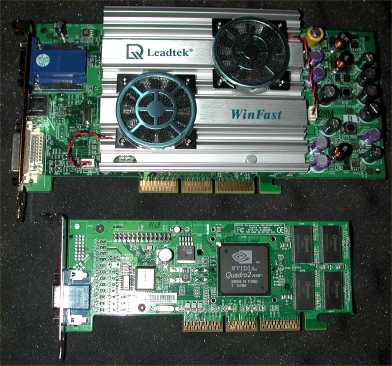
The Quadro2 MXR is a compact AGP form factor card.
===================================
Application Level Tests
 Although
COSBI will include a large number of synthetic benchmarks, the project will be
much broader than this. As we explained above, associated methodologies
will be detailed. In addition, application level tests will be an integral
part.
Although
COSBI will include a large number of synthetic benchmarks, the project will be
much broader than this. As we explained above, associated methodologies
will be detailed. In addition, application level tests will be an integral
part.
Gary Willingham has contributed the first major application level tests to COSBI. Covering Adobe Photoshop, Adobe Illustrator and AutoCAD 2002, we used these benchmarks for this review. We want to thank Gary for his help.
These tests are still in development, but like the rest of COSBI, the scripts will be released as well as the data workload.
===================================
COSBI: Adobe Photoshop 5.5
Setting the trend for things to come, the the Intel Pentium 4 is nearly 13% slower than the Athlon XP 2600+ in Adobe Photoshop, which is a margin that is easily noticeable when running the script.

The Athlon XP beats the 2.533GHz Intel Pentium 4 in Adobe Photoshop 5.5 by
almost 13%.
===================================
COSBI: Adobe Illustrator 8.0.1
Extended its lead to over 21%, the Athlon XP 2600+ is much quicker in Adobe Illustrator 8.0.1 than the 2.53 GHz Pentium 4.
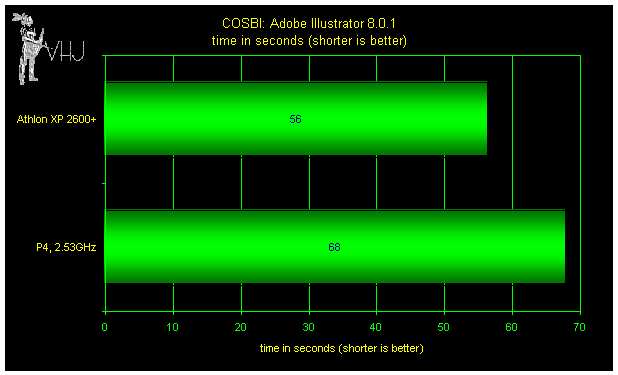
The AMD chip extends its lead over the Pentium 4.
===================================
COSBI: AutoCAD 2002
In AutoCAD 2002, the Athlon XP advantage lengthens again. The Intel Pentium 4 takes 25% longer to complete the AutoCAD script.
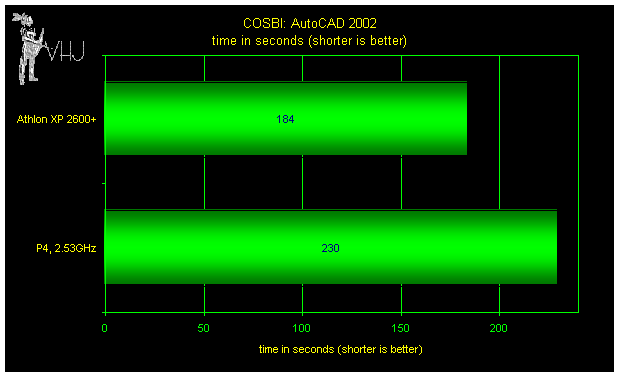
The P4 takes one-fourth more time to complete the AutoCAD script.
===================================
POV-Ray 3.5
In the popular and free POV-Ray version 3.5 raytracing program, the Intel Pentium 4 took over 35% longer to render the "chess2.pov" the Athlon XP 2600+ at 640x480, no AA.
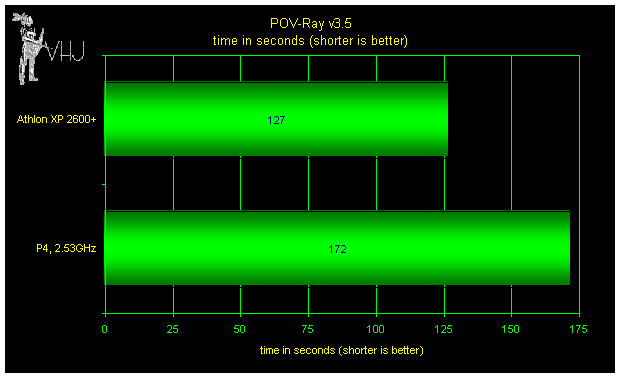
POV-Ray utilizes the Athlon XP's robust floating point unit.
===================================
Phase2
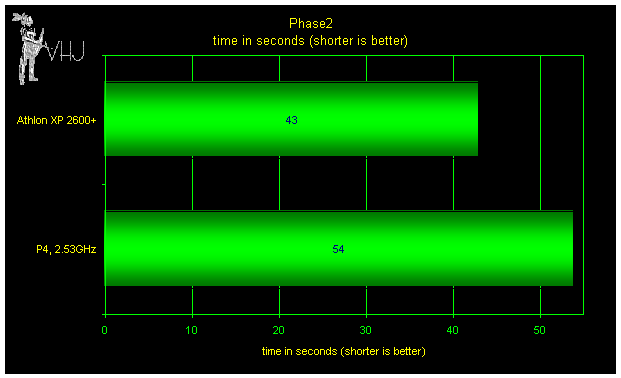
The Intel Pentium 4 takes over 25% longer to compute the "open pit"
file.
Engineering programs will often run much faster on the Athlon XP due to its more powerful floating point unit. Phase 2 is "a 2-dimensional plastic finite element program for calculating stresses and displacements around underground openings."
===================================
SysMark2000
Hoping to influence the organization for the better, AMD has told us that it has joined BAPCo as a full member. The chipmaker also has produced convincing evidence to substantiate that SysMark 2002 is broken. In fact, the data suggests a profoundly skewed workload which supports our longstanding contention that BAPCo has been essentially producing Intel marketing tools. We will cover these issues in more detail in an upcoming article.
In the meantime, we used SysMark2000 to compare performance of the two chips.
Other than in Windows Media Encoder which has a bug that handicaps the Athlon XP by not recognizing the chip's SSE capabilities, the Athlon XP either beats or essentially matches the fastest Pentium 4 that Intel currently sells.
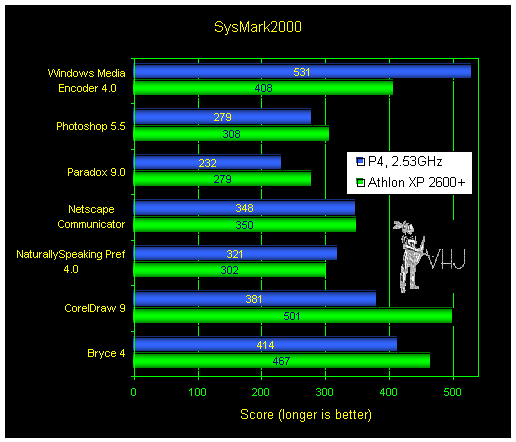
Except in the broken WME test, the Athlon XP 2600+ holds its own.
===================================
SPECviewperf 7
The Athlon XP 2600+ either beats or meets the 2.53 GHz P4 in all of the SPECviewperf tests except "proe-01" where it trails by about 10%.
Notice the lower scores for the P4 in dx-07 when moving to the GeForce4 TI4600. We experienced several anomalous scores during P4 testing that might indicate thermal throttling.
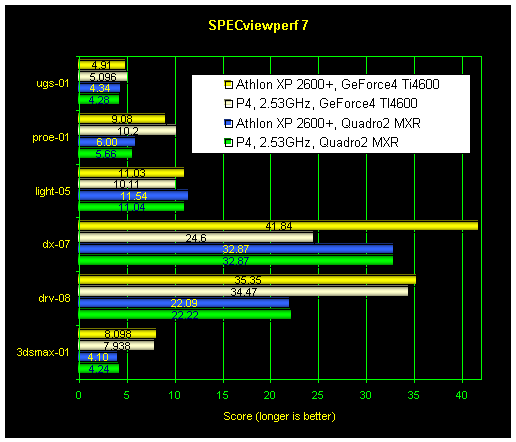
While the P4 decisively wins proe-01, the Athlon XP shines elsewhere.
===================================
BrainMaker Pro v3.75
Neural networks are growing in importance and BrainMaker Pro is a powerful neural network analysis tool. BrainMaker software can be used for "business and marketing forecasting, stock, bond, commodity, and futures prediction, pattern recognition, medical diagnosis, sports handicapping... almost any activity where you need special insight."
The Athlon XP easily bests the Pentium 4 on this application.
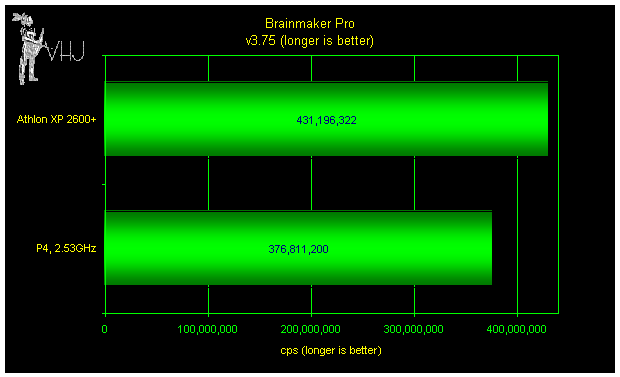
The Athlon XP is strong in BrainMaker Pro.
===================================
Coming Up...
Coming up later this week: more benchmarks, more on SysMark2002, possible P4 throttling, overclocking and the conclusion.
Click here to continue to Part 2 where we discuss AMD's stunning SysMark 2002 presentation.
===================================
Pssst! We've updated our Shopping Page.
===================================